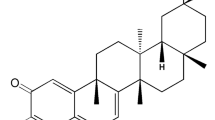Abstract
Purpose
To investigate 4-HNE expression in diabetic rat kidneys and the protective effect of probucol.
Methods
Diabetic rat models were established. Diabetic rats with successful modeling were randomly divided into the diabetic group (group D) and probucol treated group (group P). Normal rats were put into the control group (group C). Rats in group P were treated with probucol (110 mg/kg day), and rats in groups D and C were given equal volume of water instead. Serum creatinine (SCr), urea nitrogen (BUN), triglyceride (TG), total cholesterol (TC), and 24-h urinary protein were measured at the 4th, 8th, and 12th weeks. Periodic acid-schiff (PAS) staining and hematoxylin-eosin (HE) staining were used to evaluate the renal pathological changes. The immunohistochemistry and Western-blot were used to detect 4-HNE expression in renal tissue.
Results
The SCr, BUN, TG, TC, and 24-h urinary protein in group D increased in the 4th, 8th, and 12th weeks and were higher than those in group C (P < 0.05). The SCr, BUN, TG, TC, and 24-h urinary protein in group P decreased compared to group D (P < 0.05). Pathological kidney changes in group D were more serious than those in group P. The level of 4-HNE expression in group D significantly increased at the 4th, 8th, and 12th weeks and were higher than those in group C (P < 0.05). In the kidneys treated with probucol, the level of 4-HNE significantly decreased compared to group D (P < 0.05).
Conclusions
Probucol can protect the diabetic kidney by decreasing 4-HNE expression and lipid peroxidation levels.




Similar content being viewed by others
References
Fritz KS, Galligan JJ, Smathers RL et al (2011) 4-Hydroxynonenal inhibits SIRT3 via thiol-specific modification. Chem Res Toxicol 24:651–662
Soslow RA, Dannenberg AJ, Rush D et al (2000) COX-2 is expressed in human pulmonary, colonic, and mammary tumors. Cancer 89:2637–2645
Schneider C, Tallman KA, Porter NA, Brash AR (2001) Two distinct pathways of formation of 4-hydroxynonenal. Mechanisms of nonenzymatic transformation of the 9- and 13-hydroperoxides of linoleic acid to 4-hydroxyalkenals. J Biol Chem 276:20831–20838
Liu H, Zhang J, Xiong L, Liu H, Zhang L (2010) Effects of oxidative stress on white matter damage in rats model of chronic cerebral hypoperfusion. Chin J Neuromedicine 9:245–249
Yao H, Edirisinghe I, Rajendrasozhan S et al (2008) Cigarette smoke-mediated inflammatory and oxidative responses are strain-dependent in mice. Am J Physiol Lung Cell Mol Physiol 294:L1174–L1186
Lee WC, Wong HY, Chai YY et al (2012) Lipid peroxidation dysregulation in ischemic stroke: plasma 4-HNE as a potential biomarker? Biochem Biophys Res Commun 425:842–847
Xiao T, Shoeb M, H. Ansari N (2009) Metabolism and detoxification of the lipid derived aldehyde, 4-hydroxynonenal in diabetic cataractogenesis in rat. Chin J Ophthalmol 45:248–253
Gu P, Shao J, Du H et al (2010) The effects of telmisartan on intra-islet oxidative stress in db/db mice. Chin Gen Practice 13:4107–4110
Sundqvist A, Zieba A, Vasilaki E et al (2013) Specific interactions between Smad proteins and AP-1 components determine TGFbeta-induced breast cancer cell invasion. Oncogene 32:3606–3615
Jardine H, MacNee W, Donaldson K, Rahman I (2002) Molecular mechanism of transforming growth factor (TGF)-beta1-induced glutathione depletion in alveolar epithelial cells. Involvement of AP-1/ARE and Fra-1. J Biol Chem 277:21158–21166
Doorn JA, Petersen DR (2002) Covalent modification of amino acid nucleophiles by the lipid peroxidation products 4-hydroxy-2-nonenal and 4-oxo-2-nonenal. Chem Res Toxicol 15:1445–1450
Chaudhary P, Sharma R, Sharma A et al (2010) Mechanisms of 4-hydroxy-2-nonenal induced pro- and anti-apoptotic signaling. Biochemistry 49:6263–6275
Feng Z, Hu W, Tang MS (2004) Trans-4-hydroxy-2-nonenal inhibits nucleotide excision repair in human cells: a possible mechanism for lipid peroxidation-induced carcinogenesis. Proc Natl Acad Sci USA 101:8598–8602
Yokoyama T, Miyauchi K, Kurata T, Sato H, Daida H (2004) Effect of probucol on neointimal thickening in a stent porcine restenosis model. Jpn Heart J 45:305–313
Du J, Wang L, Liu X et al (2010) Janus kinase 2/signal transducers and activators of transcription signal inhibition regulates protective effects of probucol on mesangial cells treated with high glucose. Biol Pharm Bull 33:768–772
Acknowledgments
We thank Dongmei Meng and Changchang Liu for the assistance in the animal experiment.
Author information
Authors and Affiliations
Corresponding author
Ethics declarations
Conflict of interest
The authors declare that they have no conflicts of interest.
Ethical approval
The protocols in this study were approved by the Ethics Committee of Qingdao Central Hospital. Animal testing was performed in accordance with the international guiding principles for biomedical research.
Informed consent
Informed consent was obtained from all individual participants included in the study.
Rights and permissions
About this article
Cite this article
Liu, G., Ji, W., Huang, J. et al. 4-HNE expression in diabetic rat kidneys and the protective effects of probucol. J Endocrinol Invest 39, 865–873 (2016). https://doi.org/10.1007/s40618-015-0428-y
Received:
Accepted:
Published:
Issue Date:
DOI: https://doi.org/10.1007/s40618-015-0428-y




